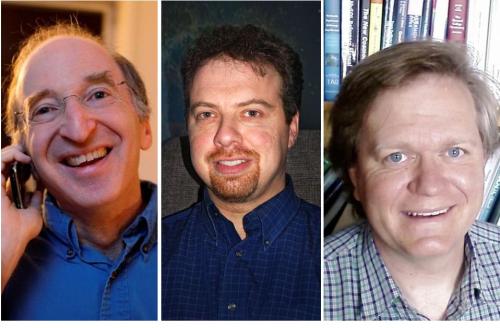Perlmutter, 52, heads the Supernova Cosmology Project at the Lawrence Berkeley National Laboratory and University of California, Berkeley.
Schmidt, 44, is the head of the High-z Supernova Search Team at the Australian National University in Weston Creek, Australia.
Riess, 41, is an astronomy professor at Johns Hopkins University and Space Telescope Science Institute in Baltimore, Maryland.
Schmidt said he was just sitting down to have dinner with his family in Canberra, Australia, when the phone call came.
``I was somewhat suspicious when the Swedish voice came on,'' Schmidt told The Associated Press. ``My knees sort of went weak and I had to walk around and sort my senses out.''
The academy said the three researchers were stunned by their own discoveries _ they had expected to find that the expansion of the universe was slowing down. But both teams reached the opposite conclusion: faraway galaxies were racing away from each other at an ever-increasing speed.
The discovery was ``the biggest shakeup in physics, in my opinion, in the last 30 years,'' said Phillip Schewe, a physicist and spokesman at the Joint Quantum Institute, which is operated by the University of Maryland and the federal government.
``I remember everyone thinking at the time (that) there was some mistake,'' Schewe said. But there was no mistake, and in fact the basic finding was confirmed later by other measurements. Other scientists found evidence for it when they analyzed the microwave radiation left over from the big bang that still bathes the universe, he said.
Perlmutter told AP his team made the discovery in steps, analyzing the data and assuming it was wrong.
``And after months, you finally believe it,'' he said. ``It's not quite a surprise anymore. I tell people it's the longest ``ah-ha'' experience that you've ever had.''
An accelerating universe means it will get increasingly colder as matter is spread out across ever-vaster distances in space, said Lars Bergstrom, secretary of the Nobel physics committee. The acceleration is believed to be driven by an unknown cosmic power, called dark energy, one of the great mysteries of the universe.
Fred Dylla, executive director of the American Institute of Physics, said the prize confirmed an idea from Albert Einstein, called the cosmological constant, that Einstein inserted in his general theory of relativity, a cornerstone of modern physics.
Einstein later repudiated that idea as his ``biggest blunder,'' but it did lead to a lot of theoretical and experimental studies, Dylla said.
The research implies that billions of years from now, the universe will become ``a very, very large, but very cold and lonely place,'' said Charles Blue, spokesman for the American Institute of Physics.
In contrast to the big bang, that fate has been called the ``big rip'' to indicate how galaxies would be torn apart, he said. Galaxies will be flying away so quickly that their light could not travel across the universe to distant observers as it does today, making the sky appear black, he said.
The Nobel committee's comment that the universe would ``end in ice'' is ``an eloquent way of putting it,'' Blue said.
The physics prize was the second Nobel to be announced this year. On Monday the medicine prize went to American Bruce Beutler and French scientist Jules Hoffmann who shared it with Canadian-born Ralph Steinman for their discoveries about the immune system. Steinman died three days before the announcement, but since his death was not known to the committee, they decided he should keep the Nobel. Since 1974, Nobels have been awarded only to living scientists.
The prestigious Nobel Prizes were established in the will of Swedish industrialist Alfred Nobel, and have been handed out since 1901.
Last year's physics award went to Russian-born scientists Andre Geim and Konstantin Novoselov for groundbreaking experiments with graphene, the strongest and thinnest material known to mankind.
The prizes are handed out every year on Dec. 10, on the anniversary of Nobel's death in 1896.
<한글기사>
초신성 연구 펄무터·슈미트·리스, 노벨 물리학상 수상
올해 노벨 물리학상은 초신성 관찰을 통해 우주 팽창 속도가 가속되는 사실을 발견한 공로로 사울 펄무터(52·미국)와 브라이언 P. 슈미트(44·미국), 애덤 G. 리스(42·호주/미국) 등 3인에게 돌아갔다.
스웨덴 왕립과학원 노벨위원회는 4일 이들이 초신성 관찰을 통해 우주의 팽창속 도가 점점 더 빨라지는 사실을 규명해 "미지의 대상인 우주의 장막을 걷어내는 데 일조했다"고 선정 이유를 밝혔다.
펄무터는 버클리 캘리포니아대, 리스는 존스홉킨스대에 각각 교수로 재직중이며 , 슈미트는 호주국립대(ANU) 교수로 미국·호주 이중국적자다.
이들은 지난 1998년께 지구에서 멀리 떨어진 50개 이상의 초신성을 관찰한 결과 이들이 폭발하면서 내뿜은 빛이 예상보다 약했다는 사실을 밝혀냈다.
노벨위원회는 이러한 현상이 우주의 팽창 속도가 빨라지고 있음을 보여주는 것 으로, 천체물리학을 뿌리부터 뒤흔든 놀라운 발견이라고 보도자료를 통해 평가했다.
펄무터는 지난 1988년부터, 슈미트는 지난 1994년부터 각자 자신의 연구진을 통해 연구를 진행했고 리스는 슈미트의 연구진에서 핵심 역할을 했다.
학계는 이처럼 2개의 연구진이 따로 연구한 결과 동일한 결론에 이르렀다는 점 에서 이러한 발견에 더욱 확신을 하게 됐다고 위원회가 밝혔다.
이들의 발견대로 우주 팽창이 계속 가속되면 우주는 최후에는 결국 얼음 상태로 끝나게 될 것이라고 위원회는 설명했다.
이 같은 가속 현상의 원인은 암흑에너지로 여겨지고 있으며, 이 암흑에너지의 정체는 아직 물리학의 최대 수수께끼 중 하나로 남아 있다.
그러나 암흑에너지는 우주 공간의 약 4분의 3을 차지하는 것으로 알려져 있어, 이번 수상자들의 발견은 암흑에너지와 같이 상당 부분 미지로 남아 있던 우주를 밝 혀내는 데 도움이 됐다고 위원회가 평했다.
펄무터는 버클리 캘리포니아대에서 박사학위를 받고 현재 같은 대학의 로런스 버클리 국립 천문대에 근무하고 있다.
미국 태생인 슈미트는 하버드대 박사를 거쳐 현재 호주국립대 교수로 있으며, 리스는 하버드대에서 박사학위를 받고 현재 존스홉킨스대 소재 우주망원경과학연구 소(STScI)에서 연구 중이다.
이번 상금 1천만 스웨덴 크로네(약 17억원) 중 절반은 펄무터에게 돌아가며, 나 머지 절반은 슈미트와 리스가 각각 나눠 받게 된다.








